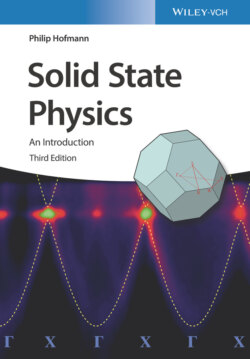Читать книгу Solid State Physics - Philip Hofmann - Страница 33
Basic Concepts
Оглавление1 1.1 Bravais lattice: Figure 1.13 shows four two‐dimensional lattices.Which of the following statements is true?All four lattices are Bravais lattices.Q is not a Bravais lattice.Q and R are not Bravais lattices.R is not a Bravais lattice.Draw the smallest possible unit cell of each lattice into the figure.Figure 1.13 Two‐dimensional lattices.
2 1.2 Basis:The left‐hand side of Figure 1.14 shows a two‐dimensional lattice with two types of atoms. We can think of the big white circles as nickel and the small grey ones as oxygen. When you describe this crystal by a two‐dimensional Bravais lattice and a basis, how many atoms are there in the basis?Figure 1.14 Left: two‐dimensional NiO crystal; Right: possible choices of the reciprocal lattice for this crystal.One.Two.Four.Nine.The right‐hand side of Figure 1.14 shows possible reciprocal lattices for this crystal. Which one is correct?
3 1.3 Unit cell of a lattice: Figure 9.6 shows a possible choice for the unit cell of barium titanate. The barium ions are located on the corners of the cube and the oxygen atoms on its faces. How many ions of the different types does this unit cell contain?Ba: 4, Ti: 1, O: 4.Ba: 8, Ti: 1, O: 6.Ba: 1, Ti: 1, O: 3.
4 1.4 The reciprocal lattice: Consider a real‐space Bravais lattice and the corresponding reciprocal lattice . Which of the following relations holds for all possible Bravais lattices? is parallel to . is perpendicular to the plane spanned by and . is perpendicular to the plane spanned by and . is perpendicular to .None of the above.
5 1.5 X‐ray diffraction: Which of the following can be determined from the positions of the spots in an X‐ray diffraction pattern?The reciprocal lattice.The Bravais lattice.Both A. and B.The position of the atoms in the unit cell.A., B., and D.
